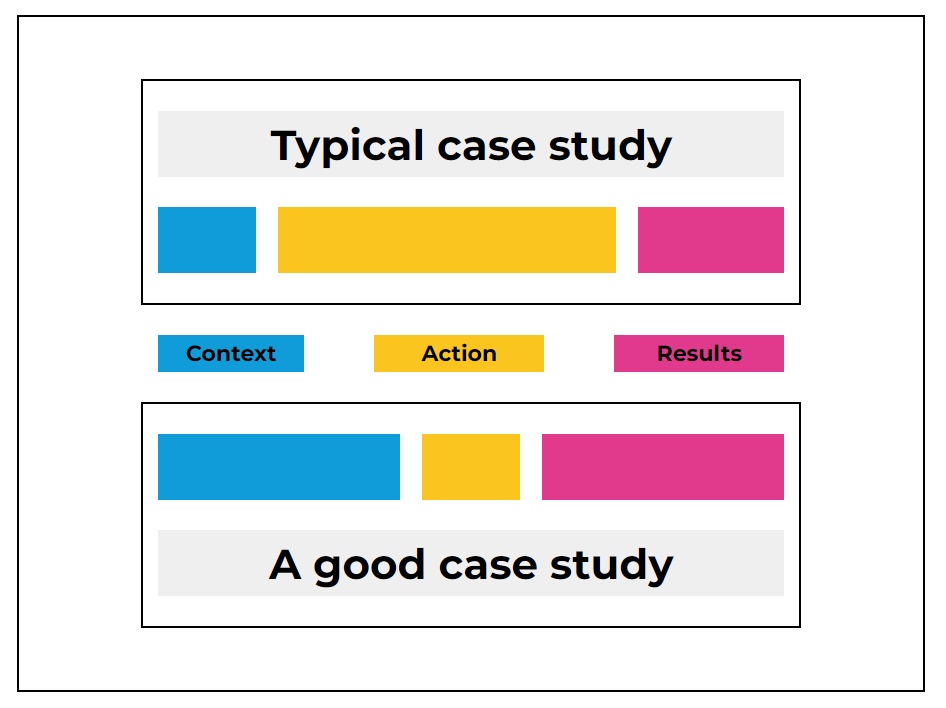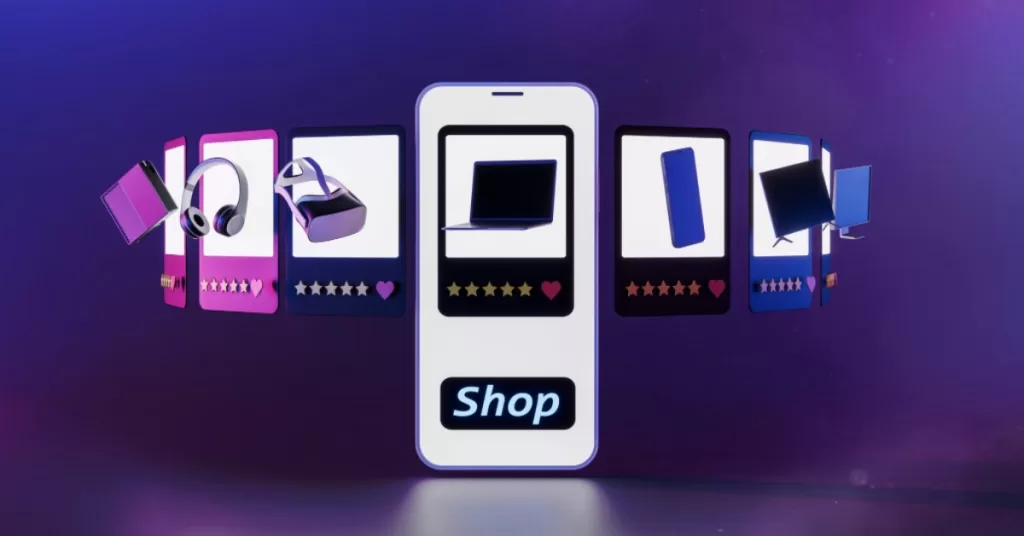B2B case studies, like a lot of other marketing materials, are all about storytelling. And when they’re done right, they can take your audience through a success story that resonates with them.
In essence, your case studies should be relatable, combining evidence and social proof while showcasing why your services are a good fit for the reader. However, I see too many companies focusing on them. What they’ve done, how great is their service, packing the case study with a lot of jargon and not focusing on the reader’s problem.
This makes them extremely boring and hard to read. But they don’t have to be! A well-crafted case study should spark the reader’s interest and convince them to have a chat with you.
Understanding What a B2B Case Study Is
For any company, showcasing their work’s results is an important part of the overall marketing strategy. This increases the consumer’s trust and makes them feel understood and hopeful that there is a solution to their problem.
The most impactful B2B case studies speak directly to a well-defined audience. Segment your audience based on industry, company size, role, or specific challenges they face.
Decision-makers in enterprise organizations have different concerns than those in small businesses. Similarly, technical users focus on different aspects than financial stakeholders.
Understanding your audience’s pain points is crucial for creating relevant content. Common B2B pain points include inefficiencies in operations, high costs, limited technical skills, compliance concerns, or scalability challenges.
Your case study should clearly show how your product or service addressed these specific issues for another business similar to your prospect’s.
A useful approach is to create audience personas for your case studies, just as you would for other marketing initiatives. These personas should include:
- Job titles and responsibilities
- Business goals and KPIs
- Day-to-day challenges
- Information sources they trust
- Decision-making authority
Effective B2B Storytelling Strategies
Effective B2B storytelling builds trust and engagement through structured narratives, visuals, and customer validation.
Structuring the Narrative
- Start with a Relatable Problem: Begin with a concise (150-200 words) problem statement outlining the client’s specific challenge, inadequate existing solutions, and negative business impact. This immediately grabs attention by addressing familiar pain points. Research shows problem statements are crucial for reader interest. Focus on the gap between the client’s current state and desired outcome, leveraging the psychological principle that people are more motivated to avoid pain.
- Show the Solution in Action: Present a logical flow of how your solution addressed each problem. Use a “hero’s journey” framework: challenge, solution encounter, implementation (with specific steps and timelines), and transformation. Detail implementation steps and include timeframes and key milestones for realistic expectations.
Developing Engaging Content
- Use Customer Quotes and Testimonials: Integrate specific quotes highlighting the challenge, solution impact, and emotional response for powerful social proof. Attribute quotes fully (name, title, company, headshot if possible) and strategically place them throughout the case study (problem validation, implementation details, results). Utilize both written and video testimonials for broader impact.
- Incorporate Visuals: Use clear charts, graphs (before/after, timelines, dashboards, process flows, screenshots) to simplify complex data and reinforce your narrative. Prioritize clarity, label elements, use consistent branding, and position visuals near relevant text. Maintain data integrity and consider interactive visuals for digital formats.
Balancing Data and Emotion
- Presenting Metrics That Matter: Focus on 3-5 key performance indicators (KPIs) across time savings, cost reduction, revenue growth, risk mitigation, and quality improvement. Provide context to explain the significance of the metrics (e.g., impact on order volume). Use a “Results at a Glance” section for skimmers, followed by detailed explanations of how results were achieved and their importance. Use comparative metrics to highlight improvements against baselines or benchmarks. For each metric, explain what was measured, how, the baseline, the improvement, and the business impact.
- Creating Emotional Connection Through Real Impact: Balance data with human stories detailing improved work lives, relieved pain points, and positive effects on company culture and customer service. Include a “Beyond the Numbers” section for qualitative improvements (collaboration, satisfaction, work-life balance). Connect solution benefits to the client’s mission and values for a strategic narrative.
Creating a Compelling Conclusion
- Summarizing Key Takeaways: Conclude with a concise (100-150 words) restatement of the challenge, solution summary, and 2-3 significant results. Avoid new information and focus on answering why this success story is noteworthy.
- Ending with Future Implications: Look beyond immediate results by suggesting potential for expanded implementation, addressing further challenges, evolving metrics, and alignment with future trends. End with a low-pressure call to action (e.g., download a guide, schedule a consultation).
B2B Storytelling framework
Every story has a clear framework based on the 3-Act Structure introduced by Syd Field in his 1978 book, ‘Screenplay’. These three acts revolve around setting the stage and presenting the world, characters, the characters’ goals, and the roadblocks preventing them from achieving their goals. The importance of achieving the results and the benefits that are at stake. And the resolution of the problem with the results derived from their actions.
If we are to put this framework in a case study, we can boil it down to:
- Context: present your customer’s issues, struggles, and pain of not being able to solve the issue they had.
- Action: how they have managed to overcome the problem, the ideation process, and the tactics they used.
- Results: the results they have achieved and how much better the position they are in is after solving the issue.
It is important to know that the case study should focus more on the context and results than the action itself. You want to convey the problem and the satisfaction and level of success that comes with overcoming it. If a prospect wants to know more about ‘the how’ they will read other marketing materials or book a call with you.

Context: Setting the stage
The most important aspect of a case study is the reader. Without readers, your case study is useless. So, you must focus on what the reader wants to get out of it and not on what you want to write about.
Let’s say you have developed the upselling app we have used as an example when discussing how to create a SaaS content strategy. In this case, your audience is struggling with scaling their business while keeping their profit margins healthy.
When writing your case study, you want to focus on that pain point and make it unbearable. You don’t want to just state the issue, you want to make sure the audience understands how bad it is.
For our example, this means that you should go beyond writing about how your customer could not profitably scale the paid advertising efforts. You can also mention that they have tried email marketing and influencer sponsorships. But they didn’t work and yielded poor results.
Action: The hero’s journey
In quite a few case studies, you can see companies focusing on their work and how their products or services fixed the issue. Even though this is true, they are shifting the focus from the customer to themselves.
Instead, write how the customer used the tool and how it helped their daily operations. If you are offering a service, talk about the conversation you had with the client and how important their input was.
Don’t focus on which features of your tool did what. The readers already know what you are offering. And if not, you have dedicated landing pages explaining your solution.
Results: the triumph
The results are the final act of your client’s story. Here, you can deep-dive in the outcomes. Again, the story should be told from your client’s point of view – not yours.
Going back to the upselling app example, this would mean that the results should not be:
“Serendipity helped [client name] increase their average order value by xx%, and increased their revenue by xx%.”
Instead, focus on the impact it had on the stakeholders and what the business can do now and in the future. It can be something like this:
“With a xx% increase in average order value, [client name] is now working on scaling their advertising and driving more revenue because they can sustain a xx% increase in customer acquisition cost. At the same time, the company is focusing on showing better product suggestions to improve the customer experience. These two actions are predicted to lead to a xx% increase in annual revenue.”
Choosing the right format
Case studies come in various formats, but the most common ones are:
- Written case studies: these are the PDFs and case study pages on your website, and they are the easiest to produce.
- Interactive/presentation case studies: this is a step up and involves the user clicking to discover more information and interact with the content.
- Video case studies: even though it is more costly to produce, video case studies showcase the people behind the numbers and make the whole story even more relatable.
Written case studies
This type of format is the most approachable one as it doesn’t require much time or resources to produce.
After you have written it, you can create a dedicated page on your website, and with enough on-page SEO, you can even get some organic traffic from it. Alternatively, you can share it as a downloadable PDF.
Moreover, you can take snippets from it and use them in your other marketing campaigns.
Interactive case studies
This format is a bit more advanced than a simple page or PDF. But it is also more engaging and helps with a better user experience.
Tools such as Foleon or Paperflite will make your life easier and allow you to animate your content in various ways, making it more attractive to read and increasing the engagement rate.
Video case study
The video format is the most resource-intensive one out there. Not only that you have to have the necessary gear and tools to film and edit everything, but you also need a higher level of commitment from your client.
With video, you can create an interview-style case study where your client is presenting their perspective on the issue they had, how it was working with you, and what the results were and what that means to their business.
Alternatively, you can also keep costs down by creating a video using a PowerPoint or Google Slides presentation. By adding some good transitions and effects, you can record your screen going through the presentation to have a video. After that, you can add a voiceover (this can also be outsourced) and be done.
The video format is more generous when it comes to creating spin-off marketing materials. You can use it as a video ad, video stills can be used as image ads, or just use quotes from the case study in other marketing materials. image ads, or just use quotes from the case study in other marketing materials.



